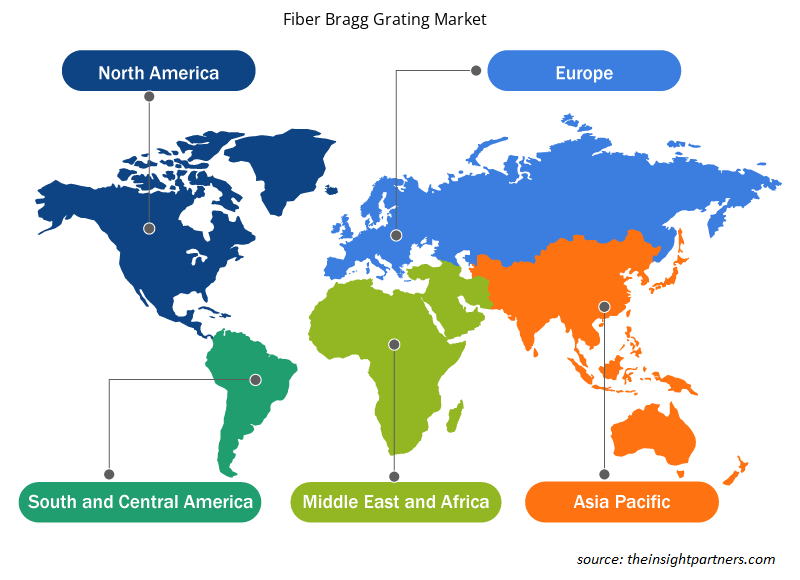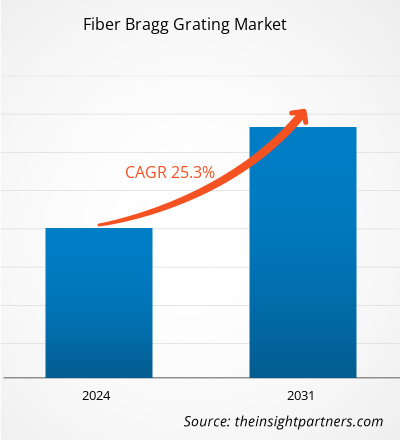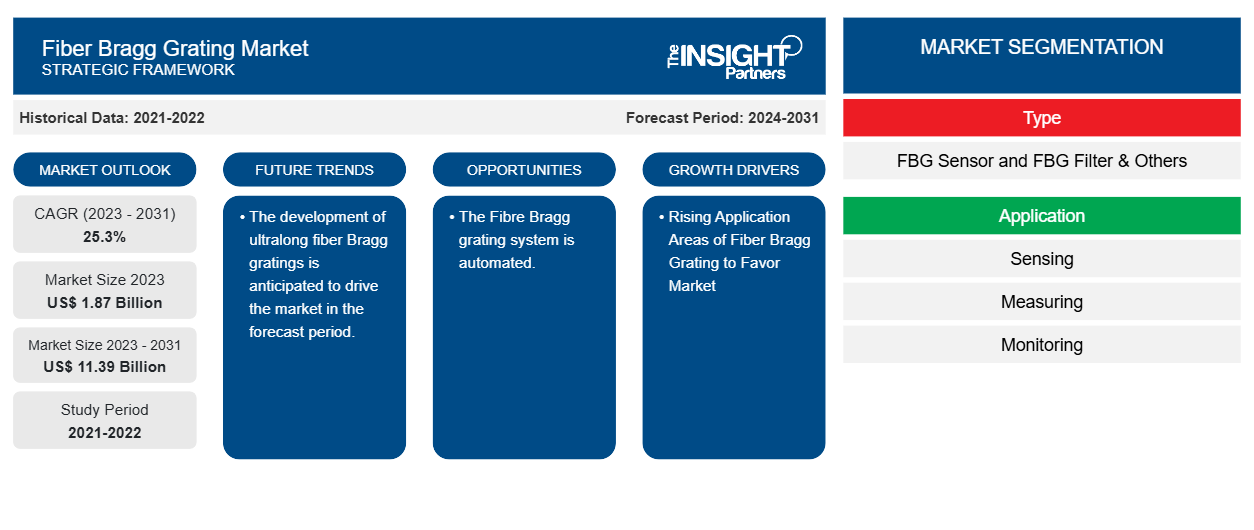ファイバー ブラッグ グレーティングの市場規模は、2023 年の 18 億 7,000 万米ドルから 2031 年には 113 億 9,000 万米ドルに達すると予測されています。市場は 2023 年から 2031 年にかけて 25.30% の CAGR を記録すると予想されています。ファイバー ブラッグ グレーティング (FBG) の応用分野の拡大と、その利点による FBG の採用増加は、今後も市場の主要なトレンドと推進要因であり続けると思われます。
ファイバーブラッググレーティング市場分析
ファイバー ブラッグ グレーティング市場は、世界的に著しい成長を遂げています。この成長は、ファイバー ブラッグ グレーティング (FBG) の応用分野の拡大と、その利点による FBG の採用の増加に起因しています。さらに、自動化された FBG システムの実装と超長ファイバー ブラッグ グレーティングの開発により、市場にはさまざまな機会が生まれることが期待されています。
ファイバーブラッググレーティング市場の概要
ファイバー ブラッグ グレーティング (FBG) は、通常数ミリメートルの長さの微細構造で、シングルモード ファイバーのコアに光刻印することができます。これは、UV レーザー ビームでファイバーを横方向に照射し、位相マスクを使用してコアに干渉パターンを生成することで行われます。これにより、シリカ マトリックスの物理的特性に永久的な変化が生じます。
要件に合わせてレポートをカスタマイズする
このレポートの一部、国レベルの分析、Excelデータパックなど、あらゆるレポートを無料でカスタマイズできます。また、スタートアップや大学向けのお得なオファーや割引もご利用いただけます。
-
このレポートの主要な市場動向を入手してください。この無料サンプルには、市場動向から見積もりや予測に至るまでのデータ分析が含まれます。
ファイバーブラッググレーティング市場の推進要因と機会
ファイバー ブラッグ グレーティングの応用分野が拡大し、市場が好調に推移。
ファイバーブラッググレーティングの応用分野の拡大が、ファイバーブラッググレーティング市場を牽引しています。ファイバーブラッググレーティングは、通信、航空宇宙、エネルギーおよび公共事業、輸送などの業界で使用されています。FBGは通信にとって重要な要素です。通信アプリケーション用のシリカファイバーへのFBGのUV刻印と比較すると、これは標準的で再現性の高い大量生産プロセスに発展しています。さらに、周波数である空間位相グレーティングの役割は、基本的にコア内に狭帯域(透過または反射)フィルターまたはミラーを形成することです。したがって、上記のパラメータを考慮すると、ファイバーブラッググレーティングの応用分野の拡大が市場の成長を牽引しています。
ファイバー ブラッグ グレーティング システムは自動化されています。
FBG は、センサーとして機能するための独自の特性を備えています。ファイバー ブラッグ グレーティング (FBG) センサーは、小型で高感度、電磁干渉に対する耐性があるため、オートメーションを含むさまざまなアプリケーションで幅広く使用されています。これらのセンサーは、特定の波長の光を反射しながら他の波長を透過することで動作し、反射された波長は温度、歪み、または圧力の変化に応じて変化します。FBG は、測定目的の特定、FBGセンサーの選択、機器との統合、光インタロゲーターへの接続、キャリブレーションなど、オートメーションのさまざまなステップで使用されます。したがって、オートメーションにおけるファイバー ブラッグ グレーティングの上記の利点と機能を考慮すると、今後数年間で市場が拡大すると予想されます。
ファイバーブラッググレーティング市場レポートのセグメンテーション分析
ファイバー ブラッグ グレーティング市場分析の導出に貢献した主要なセグメントは、タイプ、アプリケーション、および業界です。
- タイプに基づいて、ファイバー ブラッグ グレーティング市場は、FBG センサーと FBG フィルターおよびその他に分かれています。FBG センサー セグメントは、予測期間中に大きな市場シェアを占めると予想されます。
- 用途に基づいて、ファイバー ブラッグ グレーティング市場は、センシング、測定、モニタリング、その他に分類されます。センシング セグメントは、予測期間中に大きな市場シェアを占めると予想されます。
- 業界別に見ると、市場は通信、航空宇宙、エネルギーおよび公共事業、輸送、その他に分類されています。通信は予測期間中に大きな市場シェアを占めると予想されます。
ファイバーブラッググレーティングの地域別市場シェア分析
ファイバー ブラッグ グレーティング市場レポートの地理的範囲は、主に北米、アジア太平洋、ヨーロッパ、中東およびアフリカ、南米および中米の 5 つの地域に分かれています。
北米はファイバーブラッググレーティング市場を支配してきました。北米市場は、米国、カナダ、メキシコに分割されています。この成長は、この地域でのファイバーブラッググレーティングの応用分野の拡大と、FBGの利点による採用の増加に起因しています。さらに、自動化されたFBGシステムの実装と超長ファイバーブラッググレーティングの開発は、市場でいくつかの機会を保持すると予想されています。さらに、米国とカナダの先進経済における研究開発の大きな重点は、北米のプレーヤーが技術的に高度なソリューションを市場に投入することを余儀なくされています。さらに、米国には、革新的なソリューションの開発にますます重点を置いているファイバーブラッググレーティング市場のプレーヤーが多数います。これらすべての要因が、この地域のファイバーブラッググレーティング市場の成長に貢献しています。
ファイバーブラッググレーティング市場の地域別分析
予測期間を通じてファイバー ブラッグ グレーティング市場に影響を与える地域的な傾向と要因は、Insight Partners のアナリストによって徹底的に説明されています。このセクションでは、北米、ヨーロッパ、アジア太平洋、中東、アフリカ、南米、中米にわたるファイバー ブラッグ グレーティング市場のセグメントと地理についても説明します。

- ファイバーブラッググレーティング市場の地域別データを入手
ファイバーブラッググレーティング市場レポートの範囲
| レポート属性 | 詳細 |
|---|---|
| 2023年の市場規模 | 18億7千万米ドル |
| 2031年までの市場規模 | 113.9億米ドル |
| 世界のCAGR(2023年~2031年) | 25.3% |
| 履歴データ | 2021-2022 |
| 予測期間 | 2024-2031 |
| 対象セグメント |
タイプ別
|
| 対象地域と国 |
北米
|
| 市場リーダーと主要企業プロフィール |
|
市場プレーヤーの密度:ビジネスダイナミクスへの影響を理解する
ファイバー ブラッグ グレーティング市場は、消費者の嗜好の変化、技術の進歩、製品の利点に対する認識の高まりなどの要因により、エンド ユーザーの需要が高まり、急速に成長しています。需要が高まるにつれて、企業は提供を拡大し、消費者のニーズを満たすために革新し、新たなトレンドを活用し、市場の成長をさらに促進しています。
市場プレーヤー密度とは、特定の市場または業界内で活動している企業または会社の分布を指します。これは、特定の市場スペースに、その規模または総市場価値と比較して、どれだけの競合相手 (市場プレーヤー) が存在するかを示します。
ファイバーブラッググレーティング市場で事業を展開している主要企業は次のとおりです。
- AOS株式会社
- アルネアラボ株式会社
- FBGSテクノロジーズ
- HBMファイバーセンシングSA
- ITFテクノロジーズ株式会社
- イクスブルーフォトニクス
免責事項:上記の企業は、特定の順序でランク付けされていません。

- ファイバーブラッググレーティング市場のトップキープレーヤーの概要を入手
ファイバーブラッググレーティング市場のニュースと最近の動向
ファイバー ブラッグ グレーティング市場は、重要な企業出版物、協会データ、データベースなどの一次調査と二次調査後の定性的および定量的データを収集することによって評価されます。ファイバー ブラッグ グレーティング市場におけるいくつかの開発を次に示します。
- フォトニクス業界のリーダー企業である TeraXion 社は、高出力の全ファイバー ブラッグ グレーティング ノッチ フィルターの新シリーズを発表しました。WSF シリーズは、全ファイバー バンドストップ (ノッチ) フィルターで、特定の波長または波長範囲を選択的に減衰またはブロックしながら、他の波長を通過させるために使用されます。(出典: TeraXion 社の Web サイト、2024 年 12 月)
ファイバーブラッググレーティング市場レポートの対象範囲と成果物
「ファイバーブラッググレーティング市場規模と予測(2021〜2031年)」レポートでは、以下の分野をカバーする市場の詳細な分析を提供しています。
- スコープに含まれるすべての主要市場セグメントについて、世界、地域、国レベルでのファイバーブラッググレーティング市場規模と予測
- ファイバーブラッググレーティング市場の動向、および推進要因、制約、主要な機会などの市場動向
- 詳細なPEST/ポーターの5つの力とSWOT分析
- 主要な市場動向、世界および地域の枠組み、主要プレーヤー、規制、最近の市場動向を網羅したファイバーブラッググレーティング市場分析
- 市場集中、ヒートマップ分析、主要プレーヤー、ファイバーブラッググレーティング市場の最近の動向を網羅した業界展望と競争分析
- 詳細な企業プロフィール
- 過去2年間の分析、基準年、CAGRによる予測(7年間)
- PEST分析とSWOT分析
- 市場規模価値/数量 - 世界、地域、国
- 業界と競争環境
- Excel データセット
最新レポート
関連レポート
お客様の声
購入理由
- 情報に基づいた意思決定
- 市場動向の理解
- 競合分析
- 顧客インサイト
- 市場予測
- リスク軽減
- 戦略計画
- 投資の正当性
- 新興市場の特定
- マーケティング戦略の強化
- 業務効率の向上
- 規制動向への対応























 無料サンプルを入手 - ファイバーブラッググレーティング市場
無料サンプルを入手 - ファイバーブラッググレーティング市場